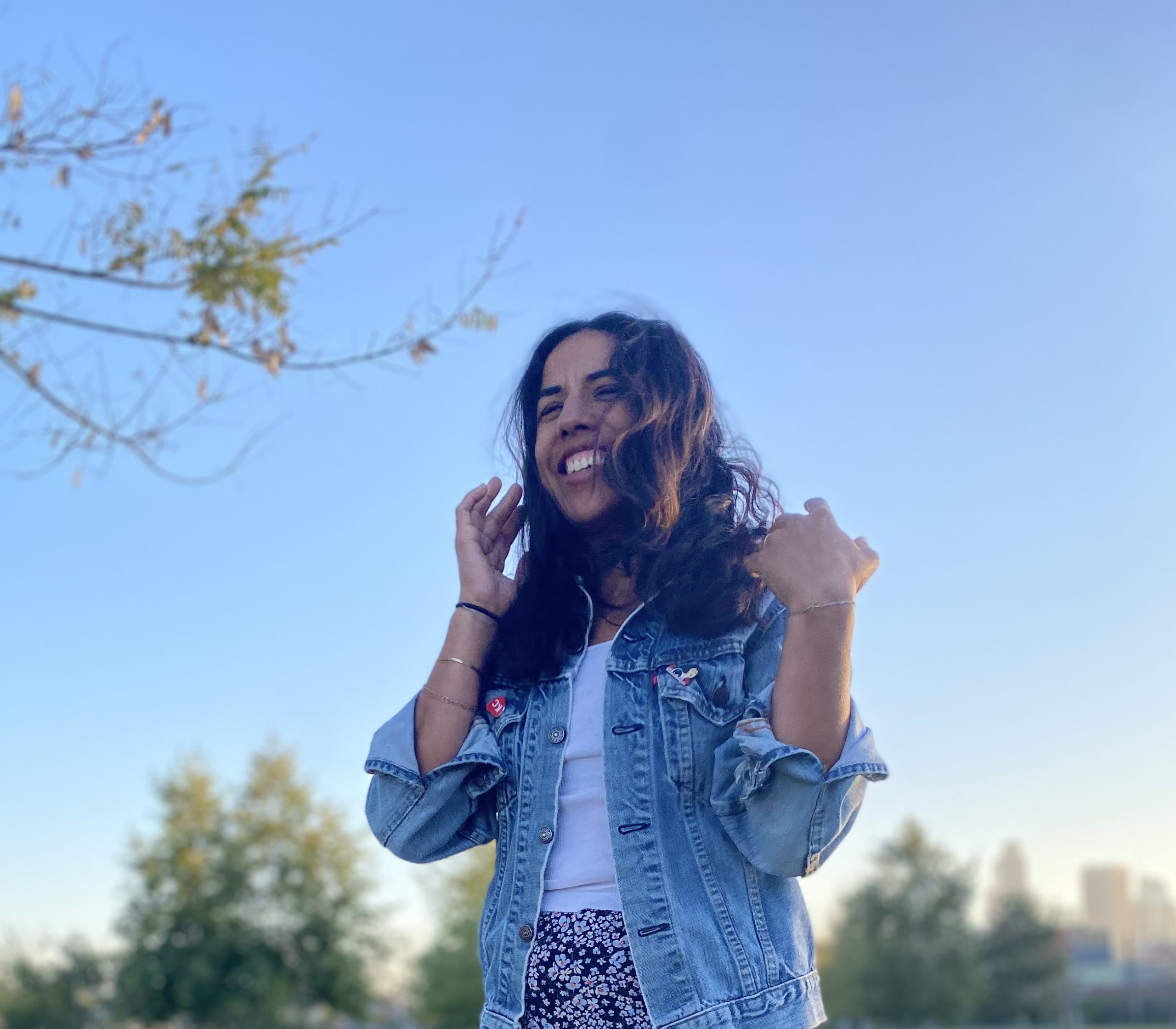Kamren Curiel
Catching & Sharing Journeys
Episode 124
Kamren Curiel is a fourth-gen Angeleno born in East L.A. on March 10, 1979, and raised in Monterey Park and South San Gabriel. She attended Potrero Heights Elementary School, Macy Intermediate, and Schurr High and graduated from South Pasadena High School. She got a degree in Journalism from San Francisco State University, lived in the Bay Area for eight years, and moved back to L.A. in 2003. She’s written for the L.A. Times, L.A. Taco, Latina magazine, LAist, KCET, and Huffington Post, and was the L.A. Editor for Remezcla.com. She loves writing untold stories about the underdog and unveiling voices that resonate with everyday people.
Kamren Curiel Takeaways
- Kamren’s family has deep roots in the San Gabriel Valley, with her first relatives living in what is now Dodger Stadium.
- Her childhood environment was culturally diverse, with a mix of Latino and Asian communities. She felt a strong connection to both cultures.
- Her interest in journalism was sparked early in her childhood but blossomed during her time at San Francisco State. She started writing for the campus newspaper and later interned at a community-based publication called The Mission.
- Her journalism career has included advocating for young incarcerated women through writing workshops. This experience influenced her decision to focus on community-based storytelling.
- Kamren has written for various publications, including L.A. Taco, KCT, L.A. IST, Huffington Post, and more. She values the readership and exposure her work receives.
- She looks forward to the Delos project, a project by the L.A. Times focused on telling Latino stories. She also wants to write about the history of South San Gabriel and continue her creative writing endeavors.
Kamren Curiel Quotes
- “The day they caught him was a huge day in my life because everyone was driving out to see where they caught him because it was a big celebration in the streets. And I remember piling into my dad’s pickup truck, and he’s like, okay, everyone, get in. We’re going to see where they caught him. And so we all piled into the back of his Toyota truck, drove to East LA, and there was just a huge party in the street where they caught the killer. Like, that was all everyone was saying, ‘Oh, they caught the killer,’ and they were celebrating. We could finally breathe. We could finally sleep.”
- “That is the area where Richard Ramirez, the Night Stalker, had his first killing. It was right by where I grew up. I was a kid at the time, and we did not go out at night. We had to lock all of our windows and make sure they were closed.”
- “Growing up, I think there was a little bit of tension because I feel like Asians perform better in school than Latinos because we grew up differently, and I think our parents pushed us differently. I feel like there was a little tension because the teachers favored the Asian kids growing up, and we felt like, ‘Oh, we’re not smart enough.”
Show Notes
What is your connection to the San Gabriel Valley?
My first relatives lived in what is now Dodger Stadium, but back in the day, there were three communities, one of which was Palo Verde, La Loma, and Bishop. And these are the three communities that were buried underneath Dodger Stadium.
My great-grandfather came from Mexico in 1912 and was one of the first descendants here. Most of my grandparents were born here. I was born in East LA, and then my family moved to Monterey Park.
I grew up there and eventually moved to South San Gabriel. It’s like a little forgotten ghost town because there’s no grocery store. We moved there when I was seven, but we have lots of family members who ended up in South San Gabriel.
Your family has been here for several generations. So you grew up in Monterey Park?
Yeah, until I was seven. We used to have a flower shop across the street from Resurrection Cemetery. It was my grandma’s flower shop, Pat’s Flowers. We took it over as the family, and I grew up working there, and Oscar De La Hoya used to come in.
I remember Potrero Grande Drive because we lived right behind the flower shop. That was very much a part of my childhood. Because we lived up on a hill, we had a view of the cemetery, which was spooky.
Where did you go to school at?
Oh, I went to Potrero Heights Elementary School, and then I went to Macy Intermediate in Monterey Park.
What was it like growing up in that part of the San Gabriel Valley?
It was interesting. It was mixed with 50% Latino and 50% Asian. All my friends were Asian, and we mixed and mingled. It was cool sharing our cultures and blending. I felt as much a part of the Asian culture as my Asian friends did with Latino culture. And we were similar in that many of us were like 2nd or 3rd generation. We were removed from culture but connected in different ways. There was a little bit of a disconnect because we weren’t speaking the native languages, but there were other things keeping us connected to our culture.
Were the schools you went to very diverse?
There were maybe one or two white kids and one or two black kids. So, there was a lack of diversity, and I want my kids to be in diverse schools because you need to have that experience of the real world to learn how to interact with different people.
Growing up, I think there was a little bit of tension because I feel like Asians perform better in school than Latinos because we grew up differently, and I think our parents pushed us differently. I feel like there was a little tension because the teachers favored the Asian kids growing up, and we felt like, ‘Oh, we’re not smart enough.’
I feel like that’s the issue with having schools that aren’t diverse enough.
Did you think the real world was similar to the community you grew up in?
No, because we grew up going to Pasadena a lot. My aunt worked at the Westcom Pasadena, and my mom worked at Apple One in Pasadena on Lake. So, we grew up always going to Pasadena, which was more of a multicultural space. My parents exposed us to different people, cultures, and scenes.
It’s interesting to hear you describe Pasadena like that because I don’t think that’s how it’s always viewed.
Yeah. One thing about LA is that it’s very segregated. You have communities that are entirely black. You have communities that are entirely Latino and Asian. In Pasadena, I feel like anything north of the 210 is where you have more black communities, and anything south of the 210 is more white. Unfortunately, I think LA is structured in a very segregated way, and I guess it goes back to the history of redlining.
You went to Schurr High School but graduated from South Pasadena.
Yes. I went to Schurr High School for my freshman year, and my mom thought I would do better at a different high school because college wasn’t in the narrative at Schurr High School.
What do you mean that wasn’t part of the narrative?
No, there wasn’t much college talk or preparation, and I didn’t hear it from a counselor or my teachers.
Yeah. It could be that’s how things were in the 90s. I started high school in 94. I used my cousin’s address, who lived in South Pasadena, to go to South Pasadena High School, which was the better school district. My brother had started the year before me and seemed to be doing better.
Then I joined him, which was like a culture shock for me because I definitely grew up not going to school with many white people. It was different because they talked differently. That’s when I started to see, oh, I’ve been exposed, but I haven’t really been to school.
It was definitely a culture shock, but there was the idea that everyone goes to college.
What was it like going to a new school?
I was lucky because my brother had started the year before, and he was very popular and made lots of friends. When I started, people were very accepting. I also had a friend growing up, and she grew up in Monterey Park, too, and ended up moving to South Pasadena. So then she started going there, and that was my good friend.
Having my brother and Jennifer there made it an easier transition.
What did you do after South Pasadena?
I went to San Francisco State. I always loved San Francisco, and that was my top college that I wanted to go to. And I loved San Francisco State because there was an activism feel and a diverse campus.
It was a commuter school with different ages and races, and I loved it. I lived in the dorms the first year, then moved out after that.
I started getting into journalism. I started interning at a newspaper, The Mission, which was big in the Latino community in San Francisco, and it was very much a community-based publication. I started interning there, which made me realize that this is what I want to do. I wanted to tell stories about what’s going on in the community.
What from your childhood in San Gabriel Valley helped move you onto this path?
I have always been in love with writing. Ever since I owned my first diary, I used to write about everything that was going on in my life. I’ve always been documenting my life in that way. And then, in journalism, you had to start writing for the campus newspaper, the Golden Gator. That’s when I got my first start of doing it for an actual publication. I talked about the war in Iraq, and there were a lot of protests in the streets.
I would write about that and some other movements that were going on. Those were the kind of things that interested me.
Once I graduated with a journalism degree, I started working with young incarcerated women and doing writing workshops with them.
I did that for a couple of years. That was really tough. So, I decided to come back to LA and really pursue journalism.
I started working at this magazine that folded, covering Latino life. That was my first big break. I started interning there and then, from there, got a job, and that position led to all my other positions.
How easy is it to get access to the community?
I have lost a lot of opportunities by not being bilingual. I can get by because I understand it and can speak a little. But it’s hard because I want to tell stories about the Latino community. And sometimes they need a translator.
I am doing a story about this program that teaches janitors to be more sustainable in the workplace, but the janitors spoke mainly Spanish, which made it hard. Luckily, they provided a translator for me, so it could be very embarrassing because people look at me like, oh, you don’t speak Spanish. They don’t understand. Unfortunately, we’ve been here for many generations, and it was just lost because, back then, my parents weren’t allowed to speak Spanish in schools.
What is it like to put something you’ve written out there?
It’s interesting. You have to check yourself. Am I doing this for my ego? Or I’m doing this because I’m passionate about it. So, I write for L.A. Taco, which has a lot of readership and gets a lot of views. So when I write a story there, I know a lot of people are seeing it, and that’s exciting. It’s important because if no one sees your work, no one will know about the story. So it’s important to have the readership.

We ask each guest to bring an item of significance with them. What did you bring with you today?
I brought a Chinese jump rope because this is what I played with growing up. This is one that my mom made for my girls.
Chinese jump rope is this lost game because I always try to get my kids to play it. I want them to take it to their friends to see if they are interested, but there isn’t any.
You write for L.A. Taco. Who else have you written for?
I write for L.A. Taco, KCT, L.A. IST, and more recently, I have been writing for Alta Journal, which is based in San Francisco. And that’s a journal. I like that it’s a print because I’ll always be into newspapers and something tangible.
I have also written for the L.A. Times and Huffington Post. And I used to be the L.A. Editor for Remescla, which is like Latin music.
How do your experiences in the SVG growing up influence your writing today?
I’m very interested in history, and I’m becoming increasingly interested in the history of the SGV. Not only does the SGV have the best food in the world, but I feel like this mix of Asian and Latin cultures coming together; I don’t know if there’s another place like it.
The SGV and where I grew up are things that I want to highlight more in my work. The history of the South San Gabriel community I grew up in has only been written about by Luis Rodriguez, a well-known writer.
Some of the famous places would be Don Bosco, Tozai Market, Resurrection Cemetery. That’s the area over there, right?
That is the area where Richard Ramirez, the Night Stalker, had his first killing. It was right by where I grew up. I was a kid at the time, and we did not go out at night. We had to lock all of our windows and make sure they were closed.
It was a scary time because a lot of the murders were in Monterey Park.
Were they? I didn’t know that.
Richard Ramirez targeted a lot of Asians. He killed a lot of Asian, older Asian people for some reason. And he liked yellow houses. So I remember it being like, ‘Oh, my God, is there anything yellow in this? Near the let’s let’s get rid of it.’
A lot of the murders happened right by Macy, where I was going to school at the time. I remember getting letters sent home care. Just be careful.
The Night Stalker was a part of my childhood.
That was an impactful time in the San Gabriel Valley
It definitely was because he mostly did his murders in the San Gabriel Valley. I remember when they finally caught him. It was like we could finally breathe. We could finally sleep at night.
They also enacted their street justice right? Like, they didn’t just catch him. I think they beat him?
They beat him down. There were two cholos in East LA who saw him on a bus. I think he got off, and they were following him, and they just grabbed him and beat him and held him down until the cops came. It was a cool little twist to the story of how they took him down.
What does the future have in store for you?
I’m excited that L.A. Times is launching this new project called Delos. They just put it out there a couple of weeks ago. It’s going to be focused on telling Latino stories. I have a few pitches out to them, and I hope to start writing for them because my dream has always been to write for the L.A. Times because it’s just been a newspaper that’s always been read in different outlets to soak up the news, but I think that’s just the one space that tells the L.A. Stories.
I also want to write the history of South San Gabriel. I’d love to write little short stories about it and dive into more of my creative writing.
If people want to read your work or get in touch with you, what’s the best way to do that?
I think the best way is to go to my Instagram @kamrencita, and then from there, you can see the link to all my work.

Kamren Curiel
Tozai: This Japanese market that was off Arroyo for so long. I mean, more than 50 years. It was the place where I was exposed to Sushi, and I have some half-Hawaiian cousins, and it would be the only place where they would get aloha soy sauce.
NBC for dim sum. That is our dim sum spot. I’m sure there are better places, but for some reason, that’s just where we always go for dim sum. And so that’s right on Garfield.
Ravello Osteria, which is on Garfield. It has the best Italian food in the area.








